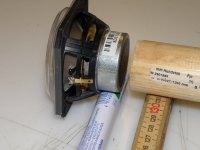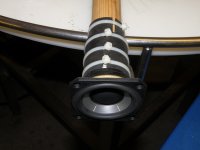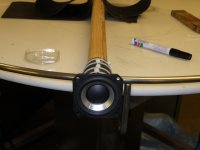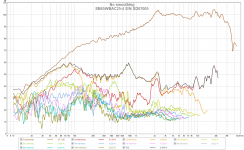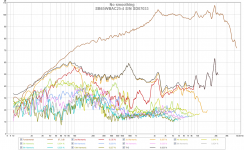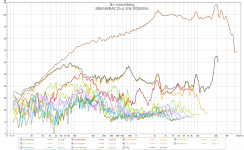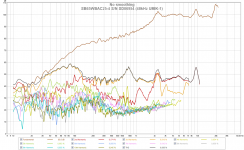I used 2 different methods of FDW in DRC, that's the top 2 graphs. (I prefer and use the second)
The second curve has some pretty high Q peaks that I would rather not try to EQ out. I prefer the smoother broad low Q curves in the low-res REW one actually. Isn't it better to be doing EQ with a soft touch rather than steep Q's?
wesayo - I'm saying to use a fixed gate before the first reflection. With the typical first reflection (doing the best we can in a room to minimize this) you're only really doing speaker correction over 1khz or so with the fdw (if it's set correctly)....and heavily smoothed at that. Below 1khz it's speaker+room correction unless you're using a ridiculously low number of cycles In which case the data will be so heavily smoothed that it's near worthless.
I still contend that the fdw is really only useful for getting an idea of what we hear at the lp.......not for actual hi-res quasi-anechoic speaker measurements. I *will* use the fdw when doing speaker/xo work to get an idea of the level below 1khz which is obscured by a short gate, but I'm not using it for eq at that point.
And that's where we differ in opinion. Not that I don't use the usual gating, just in a very different way from what you are doing with it. I wouldn't call 4 or 5 cycles a ridiculously low number, with the right tool. It's what happens within these first cycles that keeps me busy. 😛
The FDW thing doesn't keep you from measuring up close and maximising the reflection free period. As I said, EQ based on the FDW will make the plots you're looking at pretty too! Don't worry. The other way around? I'm not so sure.
I will have to wait for the more detailed instructions on what FDW I should be using then. However, given that the 1/6th octave may not be ideal in REW, it still, nonetheless has produced some nice results for the EQ'ing that both Bushmeister and I have performed thus far. I still add some manual tweaks afterwards - but very small ones.
It has prevented over correction but might have left a few tweaks on the table. You could use DRC to generate a minimum phase FDW, to base your EQ on. It's free, available, nothing to stop you 🙂.
In a way you 2 have proven my point. More resolution could have even more potential. But there always will be a point where you can go a bit too far.
It remains a balancing act between what we hear, how we hear it and what we measure.
Last edited:
I'd prefer to see those high q peaks so i can determine the cause......rather than not even knowing they exist [emoji6] .The second curve has some pretty high Q peaks that I would rather not try to EQ out. I prefer the smoother broad low Q curves in the low-res REW one actually. Isn't it better to be doing EQ with a soft touch rather than steep Q's?
wesayo - sorry I wasn't clear. By ridiculously low fdw I meant 1 or 2. Four or 5 cycles will include room reflections below 1khz or so depending on the first reflection.
I don't really mean to keep harping on this, but I see a lot of cool things and good science going on in this thread and the widespread use of the fdw with heavy smoothing for loudspeaker measurements has me scratching my head. It seems there are a few newer builders participating here so I'd like to present the "normal" way to take hi-res loudspeaker measurements.
To me, using the fdw for a speaker measurement is like driving a finishing nail with a 5lb hammer [emoji6] . I guess we'll agree to disagree.
And to me the usual use of gating is like trying to get on a train that has already left the station 🙂.
Think of what a PEQ cut or boost really is and why we should use it. A graph like this would make it more clear:

There's nothing wrong with applying science to get good results. This is just a different view on things.
Even if you gate before the first reflection, your note at 3000 KHz been finished already and stuff does
happen to it afterwards, I like to get the peak correct, the rest is up to the quality of the driver(s) and
the environment. To get that peak in sight, I use a FDW. Though I didn't use the one in REW as I use
DRC-FIR and determine when and where to get that peak just right.
That hammer would be way more like a feather to me, especially in REW! A hammer would be disastrous,
while we are trying to do the opposite, no more than strictly needed. How much that is depends on who's
doing the correction, it's a free choice.
In a way, you are missing the nail, as it's a moving target! 😉
Think of what a PEQ cut or boost really is and why we should use it. A graph like this would make it more clear:

There's nothing wrong with applying science to get good results. This is just a different view on things.
Even if you gate before the first reflection, your note at 3000 KHz been finished already and stuff does
happen to it afterwards, I like to get the peak correct, the rest is up to the quality of the driver(s) and
the environment. To get that peak in sight, I use a FDW. Though I didn't use the one in REW as I use
DRC-FIR and determine when and where to get that peak just right.
That hammer would be way more like a feather to me, especially in REW! A hammer would be disastrous,
while we are trying to do the opposite, no more than strictly needed. How much that is depends on who's
doing the correction, it's a free choice.
In a way, you are missing the nail, as it's a moving target! 😉
Last edited:
I don't know the nuances well enough, but I do see that looking at the 6th oct FDW (although appears artificially smooth) works pretty well. We can all see the resulting flatness of the frequency response when un-smoothed (if you want to see the peaks, you can see that in the HD plots which do not have the FDW applied to them). In a way, I am quite surprised how well it works and I agree that if the source or root cause of the dip or peak is intrinsic in the driver or speaker assembly, then we need to catch it early and correct with a light touch. This light touch appears to propagate well when allowed to interact with reflections from room boundaries. It is much more instructive than trying to EQ the full effect with later reflections of stuff that has "happened already".
Given that we have 6 PEQ's (in miniDSP) per channel at our disposal and 6 more overall to apply to all channels, we must use them sparingly. You can always look at the peak and try to get rid of it later. I did see one peak that was at 19kHz that was not caught by the REW FDW, but showed up in all the IR's as massive 19kHz ringing. I finally went in and applied a sharper Q=3.5 notch to cut it down and reduce the ringing. This may be one example of how the FDW in DRC would be better. I guess I need to download DRC and start using it.
Wesayso, if you want, I can contact the author of REW to alert him to this and maybe we can get a software update that addresses it in a future release. However, I don't know enough the describe the problem. Can you succinctly explain the problem as if you are showing the code developer what to change?
Given that we have 6 PEQ's (in miniDSP) per channel at our disposal and 6 more overall to apply to all channels, we must use them sparingly. You can always look at the peak and try to get rid of it later. I did see one peak that was at 19kHz that was not caught by the REW FDW, but showed up in all the IR's as massive 19kHz ringing. I finally went in and applied a sharper Q=3.5 notch to cut it down and reduce the ringing. This may be one example of how the FDW in DRC would be better. I guess I need to download DRC and start using it.
Wesayso, if you want, I can contact the author of REW to alert him to this and maybe we can get a software update that addresses it in a future release. However, I don't know enough the describe the problem. Can you succinctly explain the problem as if you are showing the code developer what to change?
Gating is a less perfect way to see what we are hearing. Ideally, we would want a continuously sliding window that becomes larger and larger with reducing frequency. So, short window at the top, long window at the bottom. This is how we hear and this is exactly what the FDW is doing, whether in DRC or REW. But, in a good speaker away from the room boundaries, gating and FDW should produce very similar, if not identical, results before reflections muddy the picture.
In a way, FDW would be better because you can get the whole range in one go. You can never see what is happening below the gate in a gated measurement. Also, a gated measurement's resolution is limited by the gate. If your gate is 5 ms, the resolution is only 200 Hz. So, narrowband resonances could be missed. In FDW, you could miss the severity of a resonance if it keeps ringing for a long time, but then you've got bigger problems.
Having said that, it appears that FDW is not ready for prime time yet. When I gate measurements, I get the same results in Holm, REW and ARTA. Clearly, there is work to be done on the FDW option. It's a great boon to have, and it's certainly the only thing that is reliable below the gate.
In a way, FDW would be better because you can get the whole range in one go. You can never see what is happening below the gate in a gated measurement. Also, a gated measurement's resolution is limited by the gate. If your gate is 5 ms, the resolution is only 200 Hz. So, narrowband resonances could be missed. In FDW, you could miss the severity of a resonance if it keeps ringing for a long time, but then you've got bigger problems.
Having said that, it appears that FDW is not ready for prime time yet. When I gate measurements, I get the same results in Holm, REW and ARTA. Clearly, there is work to be done on the FDW option. It's a great boon to have, and it's certainly the only thing that is reliable below the gate.
Well said, Ra7. The FDW let's you see below the gate into the bass 🙂
Not if you leave that gate on! 😉
A program like APL_TDA lets you "view" the reflections separately as seen in my plot. That should build up the confidence of what it is you are correcting. TDA also works with frequency dependant windowing. Of coarse another implementation with possibly different results.
I still use gating in REW, just never "static". I want to know and see what happens over time.
Last edited:
How bout this.........take em outside and get a window into the speaker instead of a speaker through a window?
Would you be surprised that even outside I would still want to know how things look with a FDW? Even in an Anechoic room? Can you figure out why I would want that? (the answer is in this thread already)
That does not mean or exclude I'd be looking at other graphs as well.
Enough about the FDW, lets move on with the bookshelf horns and make them display the magic in the music.
That does not mean or exclude I'd be looking at other graphs as well.
Enough about the FDW, lets move on with the bookshelf horns and make them display the magic in the music.
Last edited:
I do......yes.
There's a classic difference of opinion and procedure between commercial speaker builders and DIYers where IN THE TRUE SPIRIT OF DIY, the builder is creating the speaker for use in his environment and how the perform in his environment is the paramount function.....so your methodology makes perfect sense. It's only when the system is considered by others based on your measurment criteria that raises questions and deviates from anechoic performance measurements........Some DIYers may choose to consider such heavily before choosing a kit to build............which doesn't make it the right choice but only the way it's always been done. It's hard to get away from tradition as tradition has been responsible for some of the greatest creations and experiences in the relatively short history of human beings. That being said, i can remember a time when Rock and Roll was considered noise when compared to 'traditional' music of the era. Progress or poison......you pick!
There's a classic difference of opinion and procedure between commercial speaker builders and DIYers where IN THE TRUE SPIRIT OF DIY, the builder is creating the speaker for use in his environment and how the perform in his environment is the paramount function.....so your methodology makes perfect sense. It's only when the system is considered by others based on your measurment criteria that raises questions and deviates from anechoic performance measurements........Some DIYers may choose to consider such heavily before choosing a kit to build............which doesn't make it the right choice but only the way it's always been done. It's hard to get away from tradition as tradition has been responsible for some of the greatest creations and experiences in the relatively short history of human beings. That being said, i can remember a time when Rock and Roll was considered noise when compared to 'traditional' music of the era. Progress or poison......you pick!
bushmeister,
Know i'm not a star anymore but job and life got between, there is light ahead and had just got back from workshop where created below non magnetic flexible rubber interface for SB65WBAC25-4 to mount on a second microphone stand.
Know i'm not a star anymore but job and life got between, there is light ahead and had just got back from workshop where created below non magnetic flexible rubber interface for SB65WBAC25-4 to mount on a second microphone stand.
Attachments
I measured the HD of the SB65 at low drive levels in a Nautiloss with a trapezoidal baffle. It looks line there is an inherent 7kHz HD peak that I can see starting to appear. I driven at higher SPL may crop up.
http://www.diyaudio.com/forums/full...ind-comparison-2in-4in-drivers-round-3-a.html
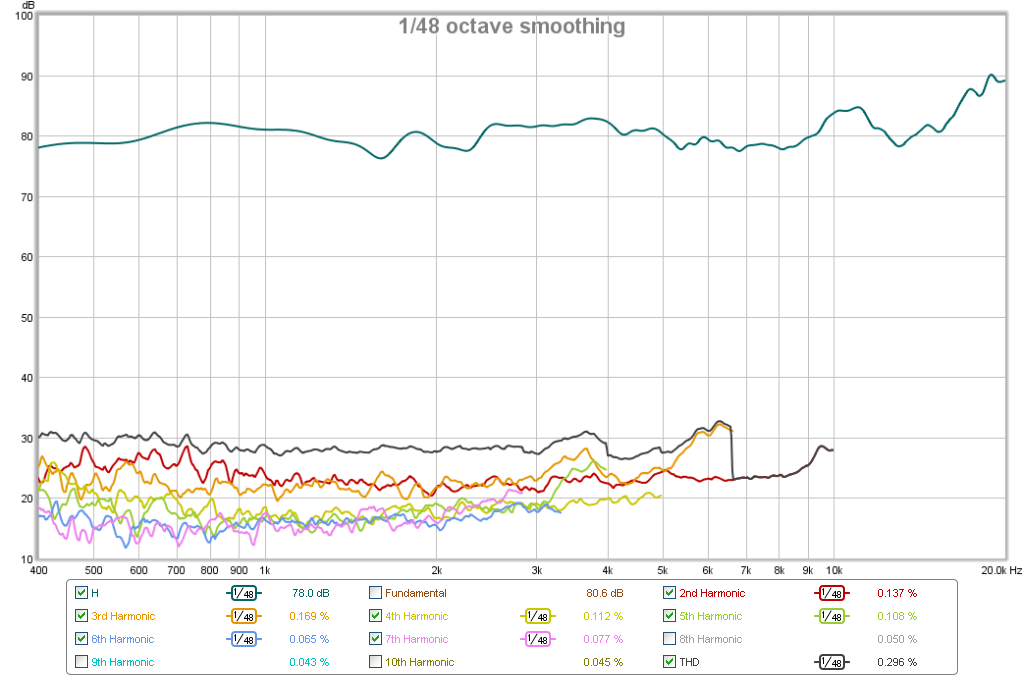
http://www.diyaudio.com/forums/full...ind-comparison-2in-4in-drivers-round-3-a.html

Last edited:
Hey X, a quick tip: If you press settings for the distortion window in REW you can choose how many orders you want to show. Instead of unmarking them below the chart.
/Anton
/Anton
.....Could you just do a quick distortion sweep at 30 cm, naked driver around 90dB?.....
3x SB65WBAC25-4 S/N: SD07005 SD07033 SD06954 mounted as a SL look alike Omni thing way as shown in previous post. First three plots are those drivers measured with new iSEMcon mic at 96kHz via M-Audio AP192, correction file for soundcard I/O and mic is active but mic preamp and power amp had not yet got calibration. Fourth and fifth is same measured driver as third, but fourth is at 192kHz and fifth is UMIK-1 USB mic at 48kHz and a shift to Java/WDM drivers where the first four is ASIO driver. Cursor is at 1kHz at all plots should any read % in legend.
Attachments
Last edited:
Thanks brytt, you are deffo still a star! Well that confirms it, I think mine is a faulty driver. I will look into getting another.
Thanks brytt, you are deffo still a star! Well that confirms it, I think mine is a faulty driver. I will look into getting another.
???.........although his measurements are at higher output, the 7khz is still there as well as an addition nasty peak at 2khz. That fact that each harmonic follows the fundamental by an octave makes his measurements fairly convincing as accurate.
Maybe I'm missing something?
The difference in 2nd and 3rd harmonic between iSEMcon mic and umik1 above 3000Hz, is it due to the difference in sample rate, measurement bandwidth or mic?
???.........although his measurements are at higher output, the 7khz is still there as well as an addition nasty peak at 2khz. That fact that each harmonic follows the fundamental by an octave makes his measurements fairly convincing as accurate.
Maybe I'm missing something?
Yep, I think you are.
At the same drive level, the 7kHz peak on mine is only 15dB down. On his it is 50dB down.
My other driver shows the same distortion profile as his.
Hence = likely a faulty driver.
(Unless I am missing something?)
Try swapping drivers between the horns, .. just to be sureYep, I think you are.
At the same drive level, the 7kHz peak on mine is only 15dB down. On his it is 50dB down.
My other driver shows the same distortion profile as his.
Hence = likely a faulty driver.
(Unless I am missing something?)
- Home
- Loudspeakers
- Multi-Way
- A Bookshelf Multi-Way Point-Source Horn
